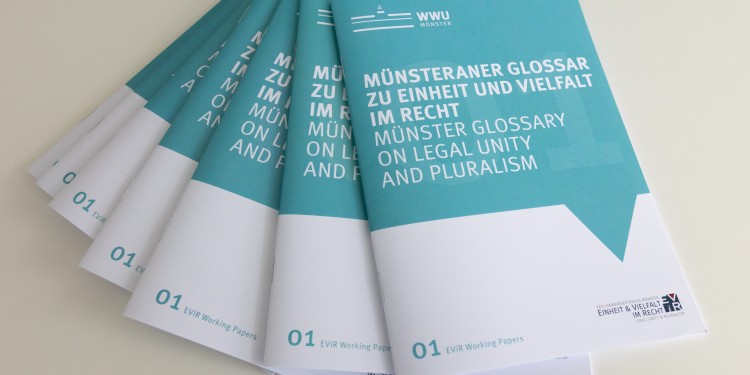
“A cross-disciplinary understanding is urgently required”
The Käte Hamburger Kolleg “Legal Unity and Pluralism” at the University of Münster is committed to interdisciplinary exchanges and international networking in the field of comparative historical legal research. The initial idea behind this is that law was at all times many-faceted and occasionally contradictory. At the same time, however, endeavours can be seen in most societies to standardise the law. The Fellows at the Kolleg are analysing the resulting tensions which span epochs, regions and disciplines. One joint project is the Münster Glossary on Legal Unity and Pluralism, which has now been published in its second edition. In this interview with Dr. Lennart Pieper, Science Communication Manager at the Käte Hamburger Kolleg, editor-in-chief Dr. Benjamin Seebröker explains the concept and describes the challenges which have to be overcome in interdisciplinary understanding.
What is the idea behind the Münster Glossary on Legal Unity and Pluralism?
Connected to the topic of legal unity and pluralism is a wide range of questions that are researched by many different disciplines – but so far it’s predominantly been a case of each discipline working by itself. So a cross-disciplinary understanding is urgently required, but it’s not that easy to achieve because legal history, anthropology, sociology or history each use different terms to describe and analyse these phenomena. Or they use the same terms, but everyone has a different understanding of what they mean. This is why we embarked on the glossary project. The aim – aligning perfectly with the aims of the Käte Hamburger Kolleg– is to support interdisciplinary dialogue by collecting different views of individual aspects of legal unity and pluralism and thus presenting the rich variety of facets which the topic involves.
How are the entries for the glossary produced?

What sort of articles can be found in the glossary?
The glossary is a work-in-progress and is being continuously expanded. Twice a year, a new edition is published in open access on the miami publications server at the University of Münster. In addition to basic terms such as “norm, legally” or “exception”, research concepts and key terms from various disciplines are presented, for example “multinormativity”, “law as culture” or “legal transplants”. This is supplemented by specific historical phenomena which display a close connection to legal unity or legal pluralism. Already published, for example, are articles on “legal plurality (Roman Egypt)”, on the “lex mercatoria”, a common customary law applied in cross-border trade; and on “pardons”, which is an important phenomenon for our topic as it remits legal consequences or punishments and can thus be considered to constitute an exception to the rule.
What challenges have to be overcome in such a project?
One thing that certainly shouldn’t be underestimated is the amount of coordination and communication necessary in such a publishing project with so many individual entries. In addition, every article is to exist in German and in English. Here, a translation can occasionally present us with unsuspected difficulties. The term “Rechtsvielfalt” can be translated as “legal plurality”, “legal pluralism” or even “legal diversity”. In the authors’ view, however, it is the brevity of the articles which presents a particular challenge. The entries are restricted to about two pages in order to make each topic as accessible as possible. At the same time, the texts should be easy to understand for non-specialists – which makes the authors’ work more difficult. However, the articles which have already appeared show impressively that this is indeed possible. They form an outstanding basis for many more entries on fascinating phenomena relating to legal unity and pluralism.
Two examples from the Münster Glossary on Legal Unity and Pluralism
“Legal pluralism” by Prof. Peter Oestmann
As generally used, in a non-technical sense, legal pluralism denotes a multiplicity of laws, in contrast to legal unity. In a narrower sense, it is understood as the existence of a variety of laws arising from a variety of contexts in a certain area at a certain time. To this extent, law denotes an ordering of human coexistence with the objective of being enforced or at least of being observed. As a descriptor, legal pluralism thus differs from multinormativity, which explicitly includes moral and religious norms in its model. Legal diversity and legal pluralism are largely used synonymously.
The manifestations of pluralism vary greatly. What is found especially frequently is the contrast between state law, supranational law and non-state law (customary law, special rights applying to indigenous or religious communities). There are widely differing types of pluralism, ranging from the legal layers of Roman law to today’s ‘forum shopping’ and the contrast between state jurisdiction and private arbitration proceedings. In the European tradition, what was of great importance over many centuries were, in particular, distinctions between learned and unlearned law, secular law and the laws of the church, written and unwritten law, and universal and particular law. If such a multiplicity of laws contains different regulations, some of which even have contradictory expectations as regards their observance, this leads to substantive legal pluralism. […]
“Law as Culture” by Dr. Andrea Nicolas
Law as culture refers to a theoretical and methodical approach in the overlapping field of sociological, anthropological and juridical legal research. Its central statement is that law is constituted by culture (and is therefore at the same time a part of culture), and that culture, in turn, is decisively shaped by law. The approach marks a cultural turn in the scientific investigation of legal phenomena. It dissents with legal opinions that assume that law exists in isolation from society and that wish to explain law solely according to its own internal logic. Instead, the law as culture approach stresses that law emerges in specific cultural and historical contexts, is culturally constructed, and in its current form and operation must also be understood in the respective social and cultural context. The approach emphasizes that law is part of culture and should not be regarded as a closed, independent domain. […]
